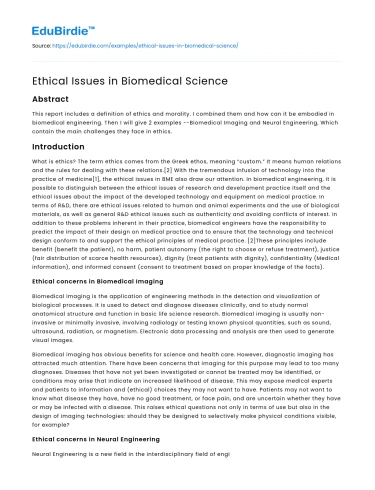Abstract
This report includes a definition of ethics and morality. I combined them and how can it be embodied in biomedical engineering. Then I will give 2 examples --Biomedical Imaging and Neural Engineering, Which contain the main challenges they face in ethics.
Introduction
What is ethics? The term ethics comes from the Greek ethos, meaning “custom.” It means human relations and the rules for dealing with these relations.[2] With the tremendous infusion of technology into the practice of medicine[1], the ethical issues in BME also draw our attention. In biomedical engineering, it is possible to distinguish between the ethical issues of research and development practice itself and the ethical issues about the impact of the developed technology and equipment on medical practice. In terms of R&D, there are ethical issues related to human and animal experiments and the use of biological materials, as well as general R&D ethical issues such as authenticity and avoiding conflicts of interest. In addition to these problems inherent in their practice, biomedical engineers have the responsibility to predict the impact of their design on medical practice and to ensure that the technology and technical design conform to and support the ethical principles of medical practice. [2]These principles include benefit (benefit the patient), no harm, patient autonomy (the right to choose or refuse treatment), justice (fair distribution of scarce health resources), dignity (treat patients with dignity), confidentiality (Medical information), and informed consent (consent to treatment based on proper knowledge of the facts).
Save your time!
We can take care of your essay
- Proper editing and formatting
- Free revision, title page, and bibliography
- Flexible prices and money-back guarantee
Ethical concerns in Biomedical Imaging
Biomedical imaging is the application of engineering methods in the detection and visualization of biological processes. It is used to detect and diagnose diseases clinically, and to study normal anatomical structure and function in basic life science research. Biomedical imaging is usually non-invasive or minimally invasive, involving radiology or testing known physical quantities, such as sound, ultrasound, radiation, or magnetism. Electronic data processing and analysis are then used to generate visual images.
Biomedical imaging has obvious benefits for science and health care. However, diagnostic imaging has attracted much attention. There have been concerns that imaging for this purpose may lead to too many diagnoses. Diseases that have not yet been investigated or cannot be treated may be identified, or conditions may arise that indicate an increased likelihood of disease. This may expose medical experts and patients to information and (ethical) choices they may not want to have. Patients may not want to know what disease they have, have no good treatment, or face pain, and are uncertain whether they have or may be infected with a disease. This raises ethical questions not only in terms of use but also in the design of imaging technologies: should they be designed to selectively make physical conditions visible, for example?
Ethical concerns in Neural Engineering
Neural Engineering is a new field in the interdisciplinary field of engineering and neuroscience. It uses engineering techniques to study and manipulate the central or peripheral nervous system. Its goals include the restoration and enhancement of human function. This is usually achieved through a direct interaction between the nervous system and artificial equipment. Nerve prosthesis has been developed to replace or improve the neurological function of the damaged nervous system. Another area of neural engineering is the brain-computer interface, in which external computing devices are connected to the brain so that signals can be exchanged. Neural Engineering also includes the development of brain implants for functional electrical stimulation of nerve cells to restore function.
In addition to the controversial forms of animal and human subject research, Neural Engineering also raises ethical issues about human integrity and dignity, because artificial neural devices may affect human identity and make human thoughts or brains part of human robots, thus turning human beings into semi robots. Besides, because neural devices can be used to control cognition, emotion, and behavior, personal autonomy can be compromised. It also raises the question of responsibility: if the human brain has been transformed into a function by others, should human beings still be morally responsible for their actions? The possibility of neuroenhancement also raises important ethical questions: should neural engineering be used to develop artificial devices that will enable humans to have better perception, cognition or motor control, or positive emotions and attitudes?
Conclusion
All in all, whether it is the issue of information selection in biomedical imaging or the issue of human integrity and dignity in neural engineering, it can be attributed to the special ethical issues that arise in human enhancement. Although the devices and technologies developed by biomedical engineers are usually to support treatment or diagnosis, they may also be designed to exceed normal levels of healthy human characteristics. This is called human augmentation, and it is morally controversial because it transcends the boundaries of the human species, so it is possible to create Superman. If the medicine is to enhance humans, it will surpass its traditional mission, which is only treatment and prevention. The enhancement may even require damage to healthy human tissues or organs to accommodate the enhancement. Therefore, whether biomedical engineers (and medical practitioners) should engage in human enhancement work remains controversial. This is a major issue facing the field of biomedical engineering in terms of ethics.
Reference
- Introduction to biomedical engineering / [edited by] John Enderle, Joseph Bronzino. – 3rd ed.
- Brey, P. (2009). ‘Biomedical Engineering Ethics.’ Eds. Berg-Olsen, J., Pedersen, S., Hendricks, V. (eds.), A Companion to Philosophy of Technology. Blackwell
- https://www.abdn.ac.uk/ims/research/abic/index.php
- http://cnecs.egr.uh.edu/






 Stuck on your essay?
Stuck on your essay?

